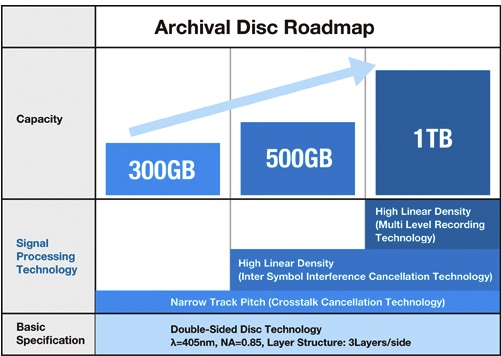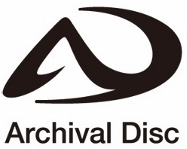Panasonic and Sony Define Archival WORM Disc at 300GB
Roadmap to reach 500GB and 1TB
This is a Press Release edited by StorageNewsletter.com on March 12, 2014 at 3:04 pmSony Corporation and Panasonic Corporation have formulated Archival Disc, a standard for professional-use, next-generation optical discs, with the objective of expanding the market for long-term digital storage.
Optical discs have properties to protect themselves against the environment, such as dust-resistance and water-resistance, and can also withstand changes in temperature and humidity when stored.
They also allow inter-generational compatibility between different formats, ensuring that data can continue to be read even as formats evolve. This makes them robust media for long-term storage of content. Recognizing that optical discs will need to accommodate much larger volumes of storage going forward, particularly given the anticipated future growth in the archive market, Sony and Panasonic have been engaged in the joint development of a standard for professional-use next-generation optical discs.
These efforts resulted in the formulation of Archival Disc, a new professional-use next-generation optical disc standard with technology roadmap, logo, and specifications.
The basic agreement to jointly develop a standard for professional-use next generation optical discs was originally announced on July 29, 2013.
Roadmap
They aim to launch systems with a recording capacity of 300GB per disc from summer 2015, onwards. In addition, both companies plan to leverage their respective technologies to further expand the recording capacity per disc to 500GB and 1TB.
The following logo has been designed to represent the Archival Disc professional-use next-generation optical disc standard.
In recent times, demand for archival capabilities has increased in the film industry, as well as in cloud data centers that handle big data, where advances in network services have caused data volumes to soar.
Both Sony and Panasonic have experience working on the development of Blu-ray Disc technology. The two companies plan to promote this next-generation high-capacity optical disc standard in the professional field in order to offer an effective solution for protecting valuable data into the future.
Key Archival Disc specifications
- Disc size (type): 300GB (write-once)
- Optical parameter: Wavelength ?=405nm, Numerical Aperture NA=0.85
- Disc structure: Double-sided disc (3 layers/side), land and groove format
- Track pitch: 0.225?m
- Data bit length: 79.5nm
- Error correction method: Reed-Solomon Code
Crosstalk cancellation technology and high-order Partial Response Maximum Likelihood (PRML) signal processing technology have been employed to achieve both larger capacity and higher playback signal quality. Crosstalk electrically removes crosstalk from the adjacent tracks that increase as the track pitch becomes narrower, to achieve high-quality playback performance. PRML is a signal processing technology that improves reproduction performance by allowing inter-symbol interference.
Comments
An appropriate archiving media, not only for cold storage, is desesperatly missing in IT industry. It needs three main specs: high capacity, long-term durability (around 100 years or better than paper), cheap price per terabyte.
UDO is not evolving. There was several attempts based on other optical technology, like M-DISC from Milleniata, a 25GB archival disc at $15 announced to last up to 1,000 years but today remaining a proprietary format with a niche market.
Currently, organizations - some of them with archivind data surpassing petabytes - generally opt for LTO Ultrium magnetic tape cartridge now at native 2.5TB for the most recent LTO-6 and supposed to have 30-year archival life, eventually for much faster HDDs culminating at 6TB, but generally with warranty up to 5 years and then their content needing to be migrated relatively frequently to other new rotating magnetic disk drives.
New Archive Disc from Sony and Panasonic is based on standard 12cm media, write-once and read only, supposed to be readable for at least 50 years as it is announced for Blu-ray discs (up to 100GB), but here not for consumers. Both companies will market the format under their respective brands.
It's a double-sided disc with three layers per side, like BDXL standardized by ISO/IEC. It used land and groove format as well as PRML. Available mid-2014 at 300GB, the roadmap goes up to 1TB with Multi Level Recording.
MLR was offered by Californian company Calimetrics founded in 1994 and burned approximately $50 million in financial funding before closing in 2005, its IP being sold to LSI.
Several fundamentals specs have not been revealed: price of the media and drive (which one?), transfer rate and access time generally low for optical discs. You can bet that there will be automation libraries to handle a bunch of discs, using some of them already offered for conventional 12cm optical discs.
A guru on optical disc technology, that prefers to remain anonymous, said to StorageNewsLetter.com: "Big question is not answered: what kind of layers are used, a fundamental information. I doubt because the multi-layer optical discs are not recommended for long-term archiving."















 Subscribe to our free daily newsletter
Subscribe to our free daily newsletter

